Last night we were so weary we didn't even bother with supper, let alone editing pictures and writing the blog. So today is a double issue covering the last couple of days.
Yesterday, 24th, we woke to sunshine on our campsite high above the spa town of Royat. Mid-morning however, the rain was back with us again accompanied by a couple of friends, Thunder and Lightning. The three of them frolicked around the mountains until the evening before going their separate ways. Our faithful friend the rain stayed on overnight pattering incessantly on Modestine's roof.
During the day, despite the weather, we went down into Royat where we explored the stream and gardens where we discovered several large volcanic bombs formed by molten lava solidifying as it was thrown out from one of the volcanoes. Further downstream we took the waters at a little 19th century circular kiosk. Three mineral sources, Eugénie, César and St. Mart, flowed from fountains and cups were provided for what was definitely a dégustation dégoûtante! All the waters tasted vile, being very hot, fizzy, acid and full of salt.
 Volcanic bombs, Royat, Auvergne
Volcanic bombs, Royat, Auvergne Ian still looking remarkably health after a tasting of St. Mart, Royat, Auvergne
Ian still looking remarkably health after a tasting of St. Mart, Royat, AuvergneNext we explored the spa building where coach-loads of curists were driven to the door where they were asked to extinguish their cigarettes before being wheeled into lifts and taken off to the treatment rooms. Outside, several staff members were enjoying a lunchtime smoke!
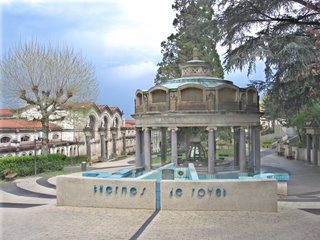 The spa buildings and public fountains, Royat, Auvergne
The spa buildings and public fountains, Royat, Auvergne Inside the foyer of the spa, Royat, Auvergne
Inside the foyer of the spa, Royat, AuvergneOn the other side of the valley park stands the casino. Inside it is decorated in classical style complete with roman statues overlooking the gaming tables. The aim of the casino seems to be to undo any good the spa treatment may have done. Here it is noisy and airless with flashing lights, no daylight and the air is thick with smoke. There are hundreds of machines à sous, nearly all occupied by people with large pots of coins, concentrating intently on feeding the machine in front of them, anticipating the noisy clanking of hundreds of euros dropping into their tray. Some were sufficiently good at gambling to operate two machines together – goody two sous! There were regular diners in the adjoining restaurant who had to break off between courses to return to the machines, so addicted were they! We found watching it all so fascinating we decided to eat there ourselves as it was still raining heavily outside. It was quite an education watching the players though the meal was not really particularly good value.
Despite the rain we were quite glad to find the daylight again outside. There are staff who appear to spend their entire working lives in that oppressive, smoky, noisy environment, drinking endless coffees and aperitifs with the customers and never seeing daylight!
A high viaduct crosses the town. It is constructed from the local volcanic stone which crystallises in hexagonal columns. Sliced across they form an unusual, attractive building stone. Nearby stand the remains of some Roman baths.
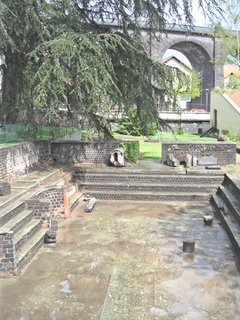 Roman baths and viaduct, Royat, Auvergne
Roman baths and viaduct, Royat, Auvergne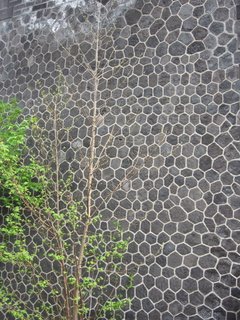 Volcanic stone commonly used in the area, Royat, Auvergne
Volcanic stone commonly used in the area, Royat, AuvergneDiscovering we were very near Clermont-Ferrand we decided to take the bus down into the city. It has a population of around 140,000 and is built on a slight rise, all that is left of a volcano. It is overlooked by the towering Puy de Dôme. The town is quite smart with many semi-pedestrianised areas. Our first impression was of the huge Place Jaude surrounded by shops and department stores. The city is built mainly of the black volcanic stone which on a dark wet day looks particularly grim and forbidding. The massive cathedral with its twin black towers was started in 1248 and is constructed in a delicate gothic style. It is actually very pleasant and the black interior offsets the church ornamentation and the 14th century stained glass windows very well.
 View down from the Cathedral with Puy de Dome behind, Clermond Ferrand, Auvergne
View down from the Cathedral with Puy de Dome behind, Clermond Ferrand, Auvergne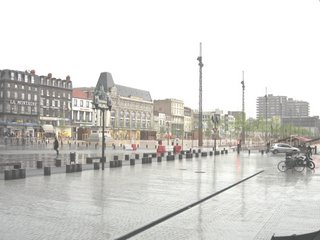 Place Jaude, Clermond Ferrand, Auvergne
Place Jaude, Clermond Ferrand, Auvergne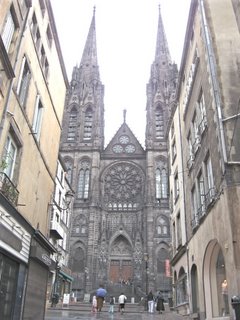 West front of the Cathedral, Clermond Ferrand, Auvergne
West front of the Cathedral, Clermond Ferrand, Auvergne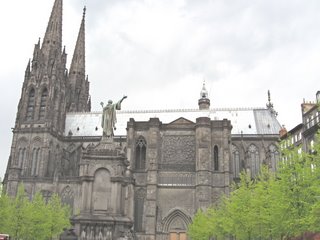 Cathedral with Pope Urban II, Clermond Ferrand, Auvergne
Cathedral with Pope Urban II, Clermond Ferrand, Auvergne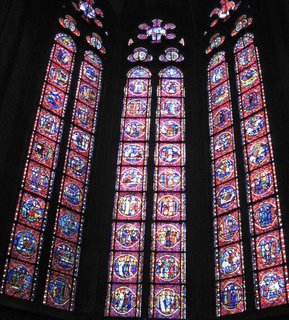 Stained glass in the Cathedral, Clermond Ferrand, Auvergne
Stained glass in the Cathedral, Clermond Ferrand, AuvergneFurther down in the city we discovered another delightful church, Notre Dame du Port, a complete contrast to the cathedral, built in Romanesque style with an arcaded apse and arched crypt. It is quite beautiful, dating from the 11th to 12 century.
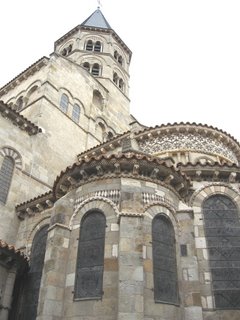 Apse of Notre Dame du Port, Clermond Ferrand, Auvergne
Apse of Notre Dame du Port, Clermond Ferrand, AuvergneNearby stands the renaissance Fontaine Amboise, 1515. Carved in black stone it has three superbly carved tiers with cherubs, creatures and water jets.
 Fontaine Amboise, Clermond Ferrand, Auvergne
Fontaine Amboise, Clermond Ferrand, AuvergneAmongst the major figures in the history of the city are Pope Urban II who preached the first crusade on what is now the Place Delille in 1095, and Blaise Pascal, a mathematician, philosopher, thinker and scientist. He is famed for discovering the weight of air, inventing an early form of computer and for his philosophical thoughts – Pensées de Pascal.
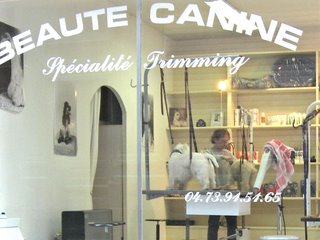 We found this both funny and distasteful! Clermond Ferrand, Auvergne
We found this both funny and distasteful! Clermond Ferrand, AuvergneAfter a fruitless attempt to load on a new blog page at one of the internet shops we caught the bus back up to Royat, still in the rain, feeling rather frustrated and that we had done no more than scratch the surface of what Clermont-Ferrand has to offer. Back in Royat we climbed up the steep streets to explore the old town with its fortified church on the summit. It seems a pleasant and lively little place. The church is a simple, Romanesque building but it was too dark inside to see much.
We rejoined Modestine and decided to drive back up to the same campsite we had used on Sunday night as it was getting late, we were both tired and wet with thundery headaches and rather sore feet! Too tired to cook, we made do with bread and cheese and mugs of tea before turning in and sleeping solidly.
This morning we woke feeling fine again except for a few blisters. The sun was back and it was a perfect day for the Puy de Dôme just a few kilometres from Royat. We did visit it several years ago but it was so misty on the top we saw very little. Then we went up on a special coach which whisks visitors to the top in a few minutes. Today we discovered the season has not yet started so either drive up or go on foot. It really is very steep and although Modestine would probably have been okay, we didn't want to push our luck. We are well hard, having climbed the rock of Gibraltar and nipped up to both the Cathar strongholds of Montségur and Quéribus, so we decided we'd walk up! It cannot be so difficult we thought; Ian's cousin Margaret in Exeter has ridden up it on her bike! (She also runs marathons, is years younger than us and slightly mad anyway.)
So leaving Modestine and our bikes in the car park below, we set off on foot to the sound of tinkling laughter from Hinge and Bracket and brays of derision from Modestine. The path was steep and very slippery and we were grateful for our hiking books and sticks, particularly coming back down. The climb was amazing, much better than by car with stupendous views of volcanoes for 20 miles around. Snow still rested thickly on northern slopes above the tree line. Because of the porous nature of the volcanic stone any water that falls permeates through into the rock leaving the tops dry and barren with just a sparse covering of grass. It was exposed and very hot as we climbed. Eventually though we reached the summit. Here there were cars and coaches that had taken the toll road to the top, but no toilets or refreshment facilities. Never mind, there were wonderful views. Apparently from here it is possible to see one eighth of the surface of France with Mont Blanc visible over 300km away in fine weather! We contented ourselves with views down into the craters of some of the nearer volcanoes and onto Clermont-Ferrand spread out over 1,000 metres below!
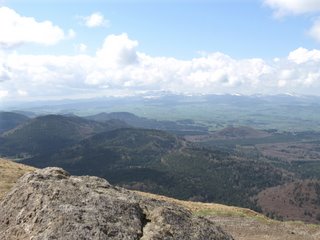 The view Modestine missed, Puy de Dome, Auvergne
The view Modestine missed, Puy de Dome, Auvergne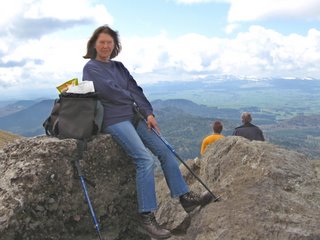 Made it! Puy de Dome, Auvergne
Made it! Puy de Dome, Auvergne Volcanic landscape! Puy de Dome, Auvergne
Volcanic landscape! Puy de Dome, Auvergne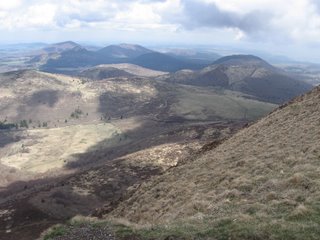 Volcanic landscape again! Puy de Dome, Auvergne
Volcanic landscape again! Puy de Dome, Auvergne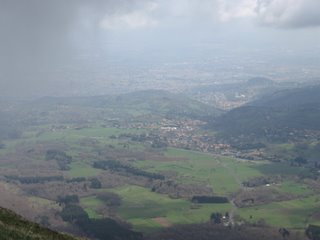 Clermond Ferrand through the haze seen from the Puy de Dome, Auvergne
Clermond Ferrand through the haze seen from the Puy de Dome, AuvergneDown below we'd seen a couple of people with enormous backpacks trying to hitch a lift to the top. Now we discovered why. They were intent on returning the quick way, by throwing themselves over the edge – attached to the parachutes they'd brought up in their packs! Several enthusiasts were gliding silently and effortlessly around the summit, swept along by thermal currents. One young man was offering rides to anyone brave enough to try, strapped in a harness with him!
 What the well-dressed hiker is wearing! Puy de Dome, Auvergne
What the well-dressed hiker is wearing! Puy de Dome, Auvergne On top of the world! Puy de Dome, Auvergne
On top of the world! Puy de Dome, Auvergne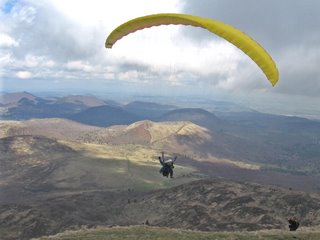 Being taken for a ride! Puy de Dome, Auvergne
Being taken for a ride! Puy de Dome, AuvergneOn the very summit, amidst the snow, is a weather research station attached to the Blaise Pascal scientific institute of the University of Clermont-Ferrand. Below it lie the remains of a Roman temple dedicated to Mercury.
Also on the summit is a monument commemorating the arrival here in 1911 of the aviator Eugéne Renaux who flew from Paris to the Puy de Dôme in five hours eleven minutes to win the prize of 100,000 francs offered three years earlier by the Michelin Tyre Company. At that time it was anticipated it would be fifty years at least before it was claimed! The Michelin brothers established their rubber company in Clermont-Ferrand in 1886 and are still based there today.
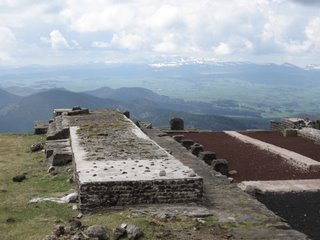 Temple of Mercury, Puy de Dome, Auvergne
Temple of Mercury, Puy de Dome, Auvergne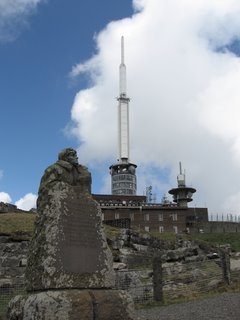 Weather station, Temple of Mercury and statue to Eugéne Renaux! Puy de Dome, Auvergne
Weather station, Temple of Mercury and statue to Eugéne Renaux! Puy de Dome, AuvergneWhat goes up must eventually come down. Hot as it had been going up we were chilled through as we started our descent which because of the loose scree took almost as long as the climb up. It was a brilliant morning's activity and well worth the price of a couple of broken blisters!
During the afternoon we made our way gradually towards Le Mont-Dore, stopping at the 12th century Romanesque basilica in the little village of Orcival. We continued to the spectacular site of the Roches Tuillière and Sandoire, two examples of the strangely crystallised volcanic lava that solidified in vertical columns. So tough is it that the rocks stand proud of their surroundings, withstanding the weathering of time. A little further on was the Lac de Guèry, over 4,000 feet up, created by a lava flow blocking the valley allowing the lake to form behind.
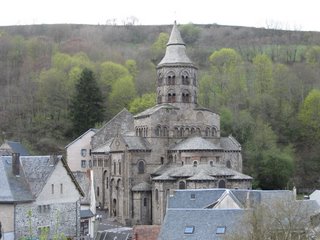 Orcival, Auvergne
Orcival, Auvergne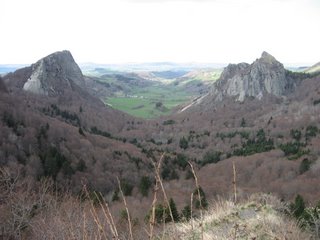 Roches Tuillière and Sandoire, Auvergne
Roches Tuillière and Sandoire, Auvergne Roches Tuillière showing lava solidified in vertical columns, Auvergne
Roches Tuillière showing lava solidified in vertical columns, Auvergne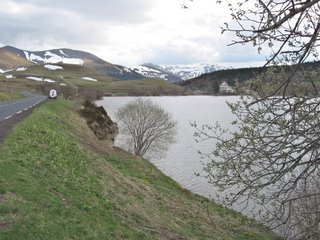 Lac de Guèry, Auvergne
Lac de Guèry, AuvergneFinally we descended down into Le Mont-Dore where we are camping on the edge of the town, the infant Dordogne just a few feet from Modestine. It is a very different river here near its source than the broad expanse we crossed during our ramblings in the Périgord on our way north last March. We have been lured back here by fond memories of the delightful town and its surrounding natural beauties. A cursory look around the town this evening convinces us we will not be disappointed.
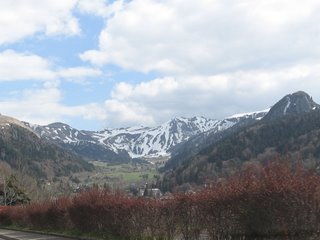 Le Mont-Dore, Auvergne
Le Mont-Dore, Auvergne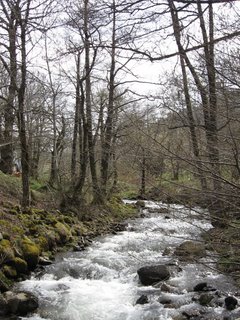 Le Dordogne at Le Mont-Dore, Auvergne
Le Dordogne at Le Mont-Dore, AuvergneWednesday 26th April 2006, Besse-en-Chandesse, Auvergne
The French are a curious nation. The campsite at Le Mont-Dore is run by the local council which sets the scale of charges which are extremely reasonable but rather peculiar. This morning when we went to pay, despite being by far the smallest vehicle on the site and having no tent, caravan or awning we were charged a couple of euros more than our neighbour with a car as long as Modestine, a huge caravan and a tent. When we questioned this we were told camping cars paid more than tents and caravans and even though we took up less space and had no on-board facilities like larger camper vans we still had to pay more because we had slept in our vehicle. We pointed out that people sleep in caravans and tents in addition to having a separate vehicle on the site. We also pointed out that Modestine is taxed and registered as a car, we pay car rates on motorways and she is really a car with refinements. It was explained very nicely that the only way around it was to put up a tent as well and we would then be charged less as it would conform to their scale of charges! Impossible to argue with the poor lass on the site so we went to the Hôtel de Ville where we were told it had nothing to do with sleeping in the vehicle, it was a question of whether there was a shower and toilet on board. Again we pointed out that we have neither and anyway caravans generally have these as well as camping cars so why the difference in price? What was the justification for charging us more when we were using less space and equipment? If we were expected to pay more we felt we were entitled to a proper explanation why. Everything was very amicable but quite unsatisfactory. Obviously someone on the council at Le Mont-Dore had thought it a reasonable idea to charge huge camping cars a bit more and hadn't thought through the consequences. Joined up thinking and common sense don't always go hand in hand with council regulations.
The next problem was to find internet access. The lass in the tourist office told us the only place we might get access in Le Mont-Dore was by seeking the goodwill of the staff at the Hôtel de Ville! We thought in view of the time we'd already wasted for them this morning goodwill may be in short supply there! It seems the town still has a way to go catering for its tourists, particularly surprising as it is an important spa centre and winter sports resort.
But the town is a very nice little place, hemmed in by volcanoes, huddled beneath the highest peak in the Auvergne, the Puy de Sancy (1,885 metres) with its snowy ski slopes. In the centre of the town are the thermes. The establishment specialises in asthmatic and lung diseases and rheumatism. The waters are used for inhalation and also applied as a vapour subcutaneously. The smell of the fumes given off from the water in the inhalation room still makes us shudder to recall!
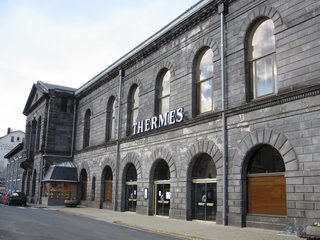 The Thermes, Le Mont-Dore, Auvergne
The Thermes, Le Mont-Dore, AuvergneDeciding to track down the source of the Dordogne we drove the few kilometres to the base of the Puy de Sancy. Here we discovered the ski slopes were still very busy with the téléphériques carrying skiers and their equipment up to the summit, returning empty in time to pick them up again once they had made their way down. We decided to go up as well, for the ride and the view. This was quite exhilarating but even with walking boots and sticks it was not practical to stray far from the station at the top. The air was fresh but not unduly chilly and we watched as parents and little children donned their skis and sped off between the poles marking the descent. Some skiers were at least our age. Maybe we've missed out on something and Ian rather envies them. We had spectacular views over the surrounding countryside. It seemed strange to see so much snow in central France. Usually one thinks of it in the Alps and the Pyrenees rather than the Massif Central.
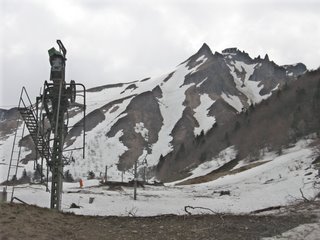 Puy de Sancy and the ski lift, Auvergne
Puy de Sancy and the ski lift, Auvergne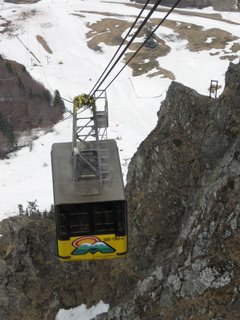 The ski lift at Puy de Sancy, Auvergne
The ski lift at Puy de Sancy, Auvergne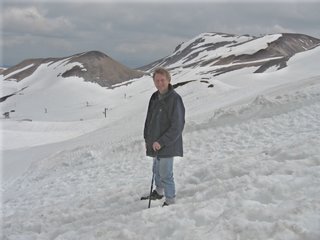 Ian feeling on top of the world, Puy de Sancy, Auvergne
Ian feeling on top of the world, Puy de Sancy, Auvergne Volcanoes and snow, Puy de Sancy, Auvergne
Volcanoes and snow, Puy de Sancy, Auvergne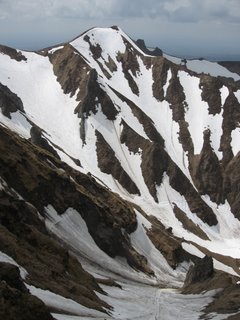 Puy de Sancy, Auvergne
Puy de Sancy, Auvergne Too exciting not to include! Puy de Sancy, Auvergne
Too exciting not to include! Puy de Sancy, AuvergneBack at the bottom we watched small children enjoying tobogganing. This looked more to Jill's taste and great fun. We also watched an express delivery man arrive on his snowmobile, a sort of motorbike on skis, roaring across the snowy hillside in a whirling spray of snow.
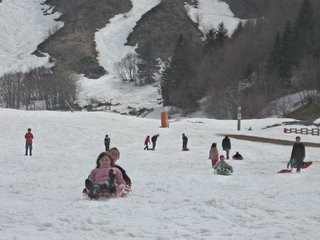 Children with their toboggans, Puy de Sancy, Auvergne
Children with their toboggans, Puy de Sancy, AuvergneWe found Modestine showing herself off to an eager crowd as usual. As usual too we opened her up and everyone peered inside, exclaimed with delight and took photos. The bikes fascinated them. Did we do much cycling? We chickened out of saying we'd become too lazy over the winter and explained that this wasn't quite the right terrain for using them.
Our Michelin guide book recommends a circular route of some 50 kms through the surrounding mountains. So we made our way down from the snowy peak, following beside the Dordogne, turning off along pretty country roads through pine forest and countryside very reminiscent of the high Jura, complete with log cabins. Soon we were passing through green meadows full of early spring flowers, particularly thousands of tiny creamy narcissi – the season is definitely later up at this height. We stopped at one little hilltop town, La Tour d'Auvergne, for bread and to investigate at close range one of the interesting rock formations of vertical columns of crystallised black basalt.
 Black basalt columns at La Tour d'Auvergne
Black basalt columns at La Tour d'AuvergneLater we visited the crater lake of Pavin with its wonderfully clear water. Our intention had been to continue to St. Nectaire, which gives its name to the local cheese with its grey mould-encrusted rind. There we knew we could find a campsite open. However, passing through Besse-en-Chandesse we discovered what seems generally to be a pleasant and inexpensive site so we have stopped here for the night instead. We now discover that although the sanitary facilities are clean and heated, the toilets are Turkish (hole in the ground and no seat.) Every site we go to has its peculiarities. Would the campsite managers like Turkish loos in their homes? Why then do they imagine campers want them? So far in our travels we have found very few sites that are really well designed, La Roche Bernard in Brittany, Urrugne in the Pays Basque, Bagatelle at Avignon and Estartit in Spain being notable exceptions.
